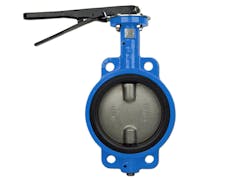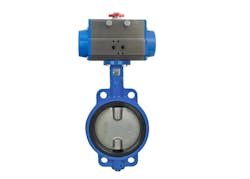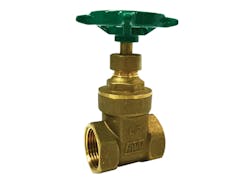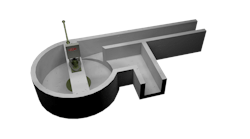Gate valves are used in a wide range of applications, most commonly in water pipelines handling process water as a utility, and in wastewater treatment. There are, however, some considerable drawbacks to this valve’s usage, mainly due to the slow closing and opening action.
The goal of most continuous processes is quickly achieving its steady state; the excessive times of the dynamic state are equivalent to process inefficiency and financial losses. Any delays in doing so can cause losses and problems, so gate valves are usually not the most optimal choice.
The reason behind the time-demanding gate movement is that the gate valve needs more than 360 degrees of hand wheel rotation from a fully open to a fully closed position. Consequently, the most common purpose of using gate valves is a restriction of medium flow. However, we frequently see them employed for controlling pressure and temperature, as well.
Gate valves can also achieve the required flow rate — the parameter we want to control — even when partially opened. In this case, it is important to keep in mind the required calculated Cv to pass the required flow. Restricting the opening of the valve beneath the required calculated Cv means the desired flow cannot be passed and thus the openness of the valve can impact the flow rate. Changing the size of the valve in question, and if kept sufficiently open, will only impact the velocity of the media but keep an equal flow rate.
During the gate's movement — which is performed either manually by the operator, or by using an actuator — water flowing through the pipeline does not have any purpose. It may be considered a complete loss because its mass flow is not the target one.
Compared to the gate valve, the butterfly valve — due to its specific construction — provides a much faster opening/closing action. The butterfly valve uses a fixed disc on a metal rod, which requires 90 degrees of rotation between the fully open and fully closed position. Let’s explore some of the other benefits for choosing butterfly valves that are as important when designing your systems.
Price
Gate valves are usually cheaper than butterfly valves for nominal diameters below DN80. However, due to their robust structure and the need for additional support, their price abruptly increases with the diameter. On the other hand, the butterfly valve has a compact design in all sizes: it requires less space for mounting even in larger pipelines, making it a more affordable option once the diameter goes over DN80. Because pipeline diameters in wastewater treatment or in water-as-a-utility applications can be quite large, the butterfly valves come are a perfect solution.
The ability of flow control
Besides acting as an off/on flow control, butterfly valves are a great solution for regulating the fluid flow rate. Due to its specific design, a butterfly valve can easily control fluids with both small and excessive flow range requirements. Butterfly valve manufacturers usually provide information on the relation between the valve’s opening and flow rate, under constant pressure conditions.
It is essential to note that valve opening represents the relative position of the valve plug to its closed position against the valve seat. The orifice pass area does not have any influence on the relationship between valve opening and flow rate. The relationship between flow rate and the orifice pass area is directly proportional for all valve types.1
Butterfly valves are divided into two groups, based on the relation between flow rate and valve opening:
Linear: This type of butterfly valve features a linear relationship between valve opening and maximum flow rate. Therefore, a 45-degree opening of the disc causes the fluid flow rate to be 50% of the maximum. Linear valves are primarily used in flow and liquid level control loops. Also, they are compatible with the systems where the expected pressure drop changes are minimal.
Equal: Equal butterfly valves are a great solution for processes in which the required water flow rate significantly varies. In the case of a butterfly valve featuring an equal percentage relation, equal increments of valve travel produce equal percentage changes in flow rate. For example, if disc displacement ranging from 20 to 40 degrees increased the flow rate by 50%, then further travel from 40 to 60 degrees will increase the flow rate by another 50%.
This means that the inherent characteristic of an equal butterfly valve is an exponential function — the information on this function is provided by the valve manufacturer.1 Equal valves are used in pressure and temperature control loops, and in systems where significant pressure drop changes are expected.
Automatic actuation
Process automation became a necessity for successful operations in modern facilities due to the numerous benefits it offers. The implementation of control valves is a wise long-term investment even for processes with minimal parameter variations. The operational costs of control valves are minimal, while their contribution in achieving and maintaining constant values of controlled variables provides immeasurable process improvements.
For example, if water is used as a cooling utility, its required flow rate depends on the temperature of the media that is to be heated. The most precise way to reach the set temperature is by adjusting water flow using a control valve. The valve's opening is adjusted using a butterfly valve actuator, which can be either electric or pneumatic. The butterfly valve actuator turns the valve's disc from 0 to 90 degrees, relative to the desired water flow.
The actuators are connected to processors that send commands according to the required actuator movement, based on processed information from the temperature sensor. The widely used industrial PID control loops are custom-tuned for every application, ensuring that a steady state is achieved as fast as possible — which is the goal of automatic actuation. It is essential to note that a butterfly valve is the optimal choice for this purpose, due to its compatibility with the typical temperatures and pressures of cooling water found in the industry.
Safety
- The butterfly valve is designed to withstand velocities up to 6 m/s, a much higher velocity than the recommended upper velocity limit of water flow in the industry: 3m/s.
- Butterfly valves include polymer-made sealing that ensures minimal leakage by default, which is not the case with the gate valve.
- In the case of actuator failure, actuators are programmed to either fail-open or fail-close, depending on the engineer's choice, and based on the conditions of a particular process. This failure mechanism makes the butterfly valve safe to operate, especially in processing wastewater with toxic contaminants. While gate valves can also use an actuator, the closing speeds can make a significant difference in protecting your equipment.
- The end of a pipeline is a place where engineers often choose to mount the gate valve. The lug butterfly valve is the perfect replacement because its design is suitable for the end-of-the-pipeline application. It is recognizable by threaded lugs cast into the valve body, used for bilateral screw connections that enable mounting on this position.2 The lug butterfly valve allows the disassembly of one side of the installation while maintaining the other side under pressure; this cannot be done with other butterfly valves, such as the wafer butterfly valve.
Conclusion
There are many applications where a gate valve presents the optimal solution for regulating medium flow, but with industrial applications and wastewater management that may not always be the case. First, from a financial perspective, a butterfly valve has lower upfront costs and causes significantly lesser operational costs due to its fast opening and closing. Second, a butterfly valve’s technical characteristics enable users to automate and optimize processes efficiently. Finally, butterfly valves are easily programmable to remain in the desired position in case of failure, and immediately send out a signal to the operators so they can act promptly. Therefore, substituting a gate valve with a butterfly valve is a wise investment.
Gilbert Welsford Jr is the founder of ValveMan.com and a third-generation valve entrepreneur. He has learned valves since a young age and has brought his entrepreneurial ingenuity to the family business in 2011 by creating the online valve store: ValveMan.com. Gilbert’s focus is building on the legacy his grandfather started, his father grew, and he has amplified.
References
- Zappe R.W., Smith Peter, Valve Selection Handbook - Engineering Fundamentals for Selecting the Right Valve Design for Every Industrial Flow Application (5th Edition), 2004
- Driscoll Ryan, Actuated Butterfly Valves 101: All You Need To Know About Their Application In Piping Systems, ValveMan, Aug 10th 2022 https://valveman.com/blog/actuated-butterfly-valves-101-all-you-need-to-know-about-their-application-in-piping-systems/





